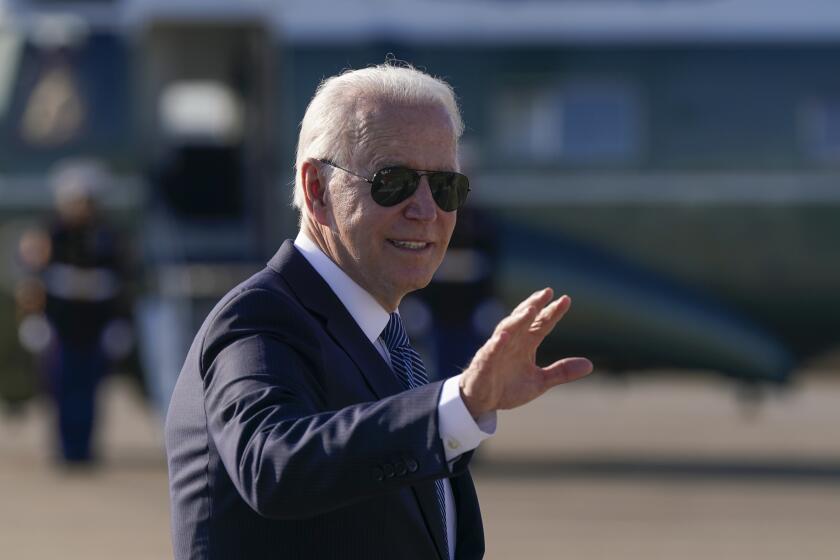L.A. Squared
- Share via
When is a public square not a public square? When it’s designed and built in Los Angeles, circa 2008. Our city--which has lacked plazas and other open-air gathering spots for so long--is now building them in a number of high-profile locations. Yet none of these spaces is fully civic in the traditional City Beautiful sense. Each one is shaped, controlled or compromised by private, commercial or other interests. Arguably, of course, that makes them right at home in Los Angeles, the most private metropolis ever devised.
Next month, the Los Angeles County Museum of Art will unveil the much anticipated first phase of its expansion, designed by the Italian architect Renzo Piano. He is probably best known for the Pompidou Center in Paris, which opens onto a square that, despite its popularity with mimes, ranks as one of the world’s great public gathering places.
Against some long odds--the kind of urban-planning gesture that works in Paris, after all, seems almost guaranteed not to work in L.A.--Piano is trying to repeat the trick at LACMA. His reconfiguration of the museum will include a plaza nearly one-third of an acre in size, partly filled with an installation of antique lampposts by artist Chris Burden. Squeezed between the old Ahmanson Building and Piano’s Broad Contemporary Art Museum, the plaza will connect the sidewalk along Wilshire Boulevard with LACMA’s new open-air entry pavilion, which is sponsored by and carries the name of the energy company BP.
About four miles east lies the new Wilshire Vermont Station, an apartment complex that is built atop a Metro Red and Purple Line station and wraps around a plaza lined with shops and restaurants. There is also the new Nokia Plaza, designed by Rios Clementi Hale Studios, at L.A. Live across the street from Staples Center.
The LAPD headquarters downtown, which is under construction, will include a large wedge-shaped public space along 1st Street facing the southern steps of City Hall. To the west of City Hall, the Civic Park (another Rios design) that is part of the Grand Avenue project will soon begin its ascent toward the Music Center.
There are a number of reasons for this plaza creep. For one, the city’s planning department, under Gail Goldberg, is taking a more active role in persuading architects and developers to open their projects to the streetscape. Rising density and a growing population are making L.A. a place where people want to get out of their cars. At the same time, simple demand for space has made private gardens--once a hallmark of middle-class life in Los Angeles--a rare and expensive commodity. One result of all those forces flowing together simultaneously is that, for the first time in the city’s history, a vocal constituency for open space is emerging in L.A.
Still, this outbreak of plazas is happening at a time when city governments around the country lack both the money and the political will to develop purely public space. L.A.’s new plazas are certainly emblematic of that weakness. There’s a good chance that the one at LACMA will be lively and smartly designed, but it will also be an extension of the BP Grand Entrance. The Civic Park’s design is being overseen, in part, by developer Related Cos., which may rent sections of the park for corporate parties as a way to raise revenue.
Perhaps most compromised of all these designs is the Nokia Plaza, which looks public and connects fluidly with the sidewalk but sits entirely on land owned by the developer AEG. In November, while reviewing the architecture of the new Nokia Theater next door, I spent a few paragraphs considering the plaza itself. I mentioned that AEG was proposing farmers markets in the space and suggested that the plaza, though it was designed primarily as a backdrop for the forthcoming ESPN studios, might also qualify as a true civic amenity for residents of the adjacent South Park neighborhood.
I soon got an e-mail from one of those residents. He explained that he’d taken his dogs for a walk and stopped by to check out the new plaza--and had been summarily tossed out because animals aren’t allowed.
Not long after receiving that e-mail, I returned to the Nokia Theater to see for myself how the plaza was actually being used. I happened to arrive on the evening of a pro-wrestling event at Staples Center. A large crowd of fans milled around in front of the arena, waiting for the doors to open, but across the way there wasn’t a soul in the attractive and expansive new plaza.
Actually, there was one soul: a security guard warily patrolling the space. There was also deafeningly loud music being played to accompany a flurry of images moving across the video screens that are placed atop six tall towers. Occasionally the screens flashed exhortatory slogans that seemed part Orwellian, part Kim Jong Il. “Do this with me!” one read in flowing digital script.
I wasn’t sure what “this” was referring to, but I was soon hustling out of the plaza and back to my car. So much for South Park’s new neighborhood gathering spot.
More to Read
The biggest entertainment stories
Get our big stories about Hollywood, film, television, music, arts, culture and more right in your inbox as soon as they publish.
You may occasionally receive promotional content from the Los Angeles Times.











